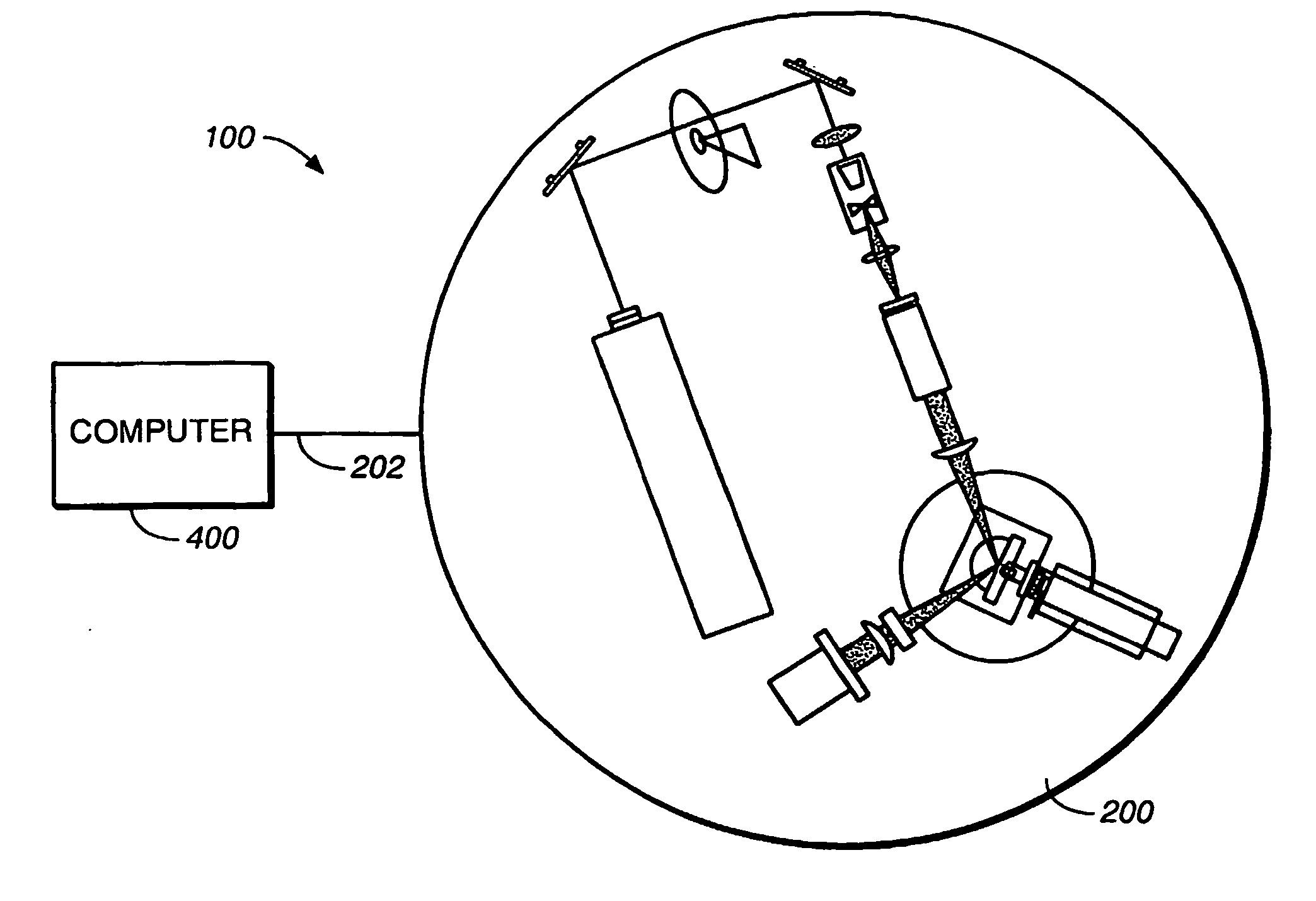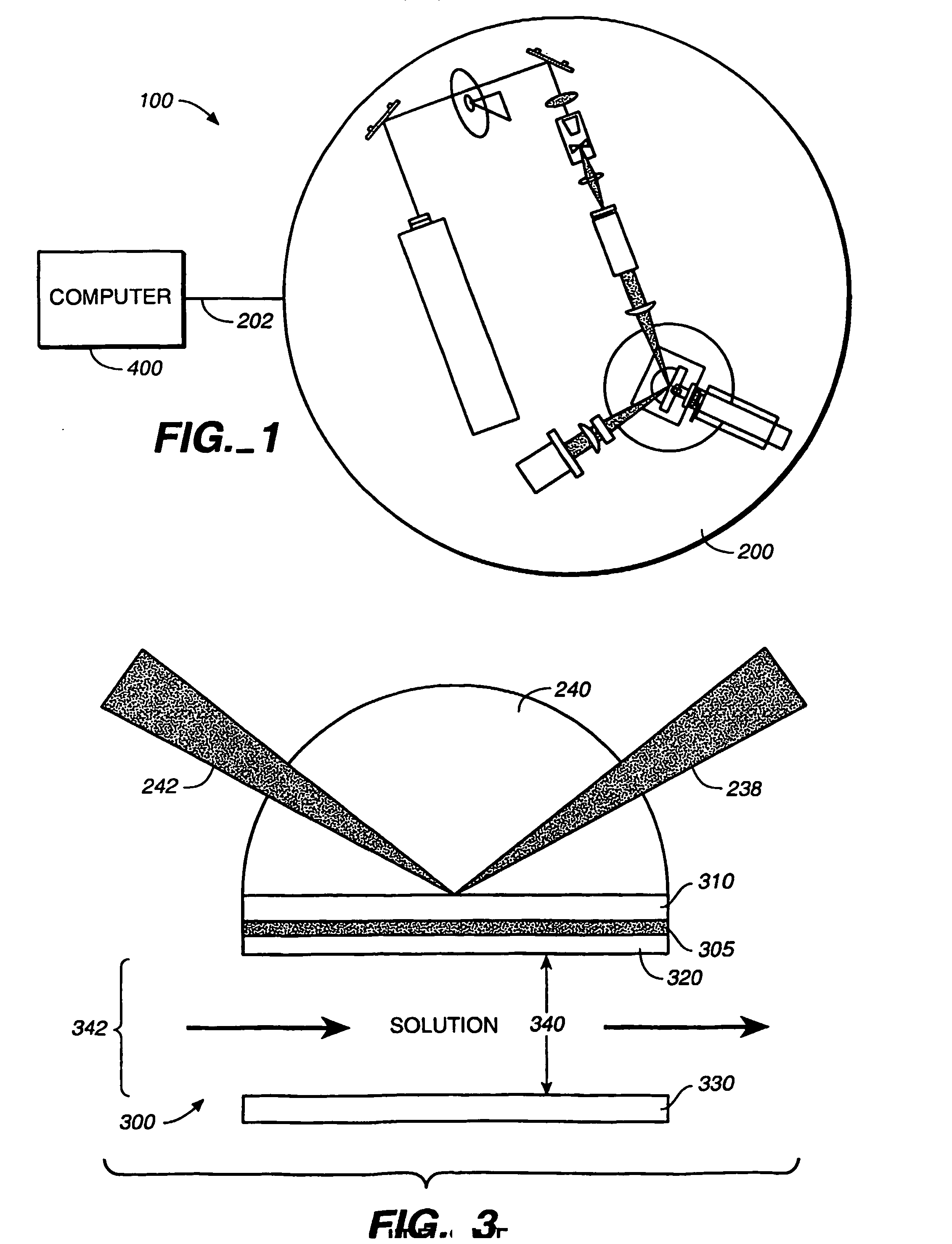System and method of measuring molecular interactions
a molecular interaction and molecular structure technology, applied in the field of systems and methods for measuring molecular interactions, can solve the problems of frapp not being able to effectively probe the gradient diffusion, affecting the effect of diffusion, and reducing the energy of reflected ligh
- Summary
- Abstract
- Description
- Claims
- Application Information
AI Technical Summary
Benefits of technology
Problems solved by technology
Method used
Image
Examples
example 1
Biotin / Avidin / Sandwich Experiment
[0121] A schematic of an experimental setup is shown in FIG. 3. In this example, a 35 mW He—Ne laser was directed by a series of mirrors through a neutral density filter (used to control incident light intensity) and into the optical train. The beam passed through a Glan-Thompson polarizer to ensure p-polarized light for the SPR experiment. A spatial filter removed stray light from the beam, yielding a more homogeneous profile, followed by a beam collimator / expander which expanded it to the appropriate diameter (˜2.5 cm.).
[0122] The widened beam was focused onto the sample cell by a vertically mounted planar cylindrical lens, as in the scanning angle reflectometry apparatus employed by Leermakers et al. Leermakers, F. A. M.; Gast, A. P., Macromolecules, 1990, 24(3), 718-730. An entire SPR spectrum can thus be captured at once on the CCD. A horizontal spectrum over an angular width of ˜8° was captured. This differs from the approach used by Lieberma...
example 2
Measurement of Enzyme Kinetics
Enzymes
[0135] A goal of the present experiment in developing this technique was to simultaneously measure the adsorption and reaction kinetics of an enzyme interacting with a substrate surface. The model substrate for this experiment was fluorescently labeled BSA. The enzyme was the serine protease subtilisin. Subtilisin adsorbs to and cleaves BSA from the surface.
[0136] For this study, variants of Bacillus lentus subtilisin (BLS) were used. This enzyme differs from the commercially available Subtilisin BPN′ (BPN) at 103 of 269 residues. Kuhn et al., Biochemistry 1998, 37, 13446-13452. BLS (MW=27 kD) is a serine protease with the characteristic Ser(221), His(64), Asp(32) catalytic triad in its active site. The reference enzyme for the experiment, which was labeled BLSv1, contained three additional mutations to the BLS structure: N76D (substitute asparagine 76 with aspartic acid), S103A (substitute serine 103 with alanine), and V1041 (substitute vali...
example 3
A Microfluidic Chip for Measuring Diffusion and Reactivity
[0147] A microfluidic chip was created for quantifying the properties of lateral diffusion and reactivity of adsorbed macromolecules measured by microfludic patterning of substrate surfaces, as shown in FIG. 17. The chip comprises a PDMS define piece (25 mm×75 mmט3 mm thickness) with an embedded channel geometry created by soft lithography techniques; a channel geometry with multiple input channels combined into a single straight channel; a channel geometry with 100-200 μm channel widths and 50 μm channel thicknesses; 1 mm diameter circular holes in the PDMS piece at each inlet and outlet to allow for the delivery of fluids to and from the chip; a glass slide of dimensions 25 mm×75 mm×1 mm sealed against the PDMS piece; a flow cell composed of multiple inputs and a single output matching those of the PDMS piece; a rectangular cutout of dimensions (25 mm×75 mm×4 mm) for placement of the microfluidic chip; an aluminum clamp w...
PUM
| Property | Measurement | Unit |
|---|---|---|
| angle | aaaaa | aaaaa |
| linear velocity | aaaaa | aaaaa |
| refractive index | aaaaa | aaaaa |
Abstract
Description
Claims
Application Information
 Login to View More
Login to View More - R&D
- Intellectual Property
- Life Sciences
- Materials
- Tech Scout
- Unparalleled Data Quality
- Higher Quality Content
- 60% Fewer Hallucinations
Browse by: Latest US Patents, China's latest patents, Technical Efficacy Thesaurus, Application Domain, Technology Topic, Popular Technical Reports.
© 2025 PatSnap. All rights reserved.Legal|Privacy policy|Modern Slavery Act Transparency Statement|Sitemap|About US| Contact US: help@patsnap.com



